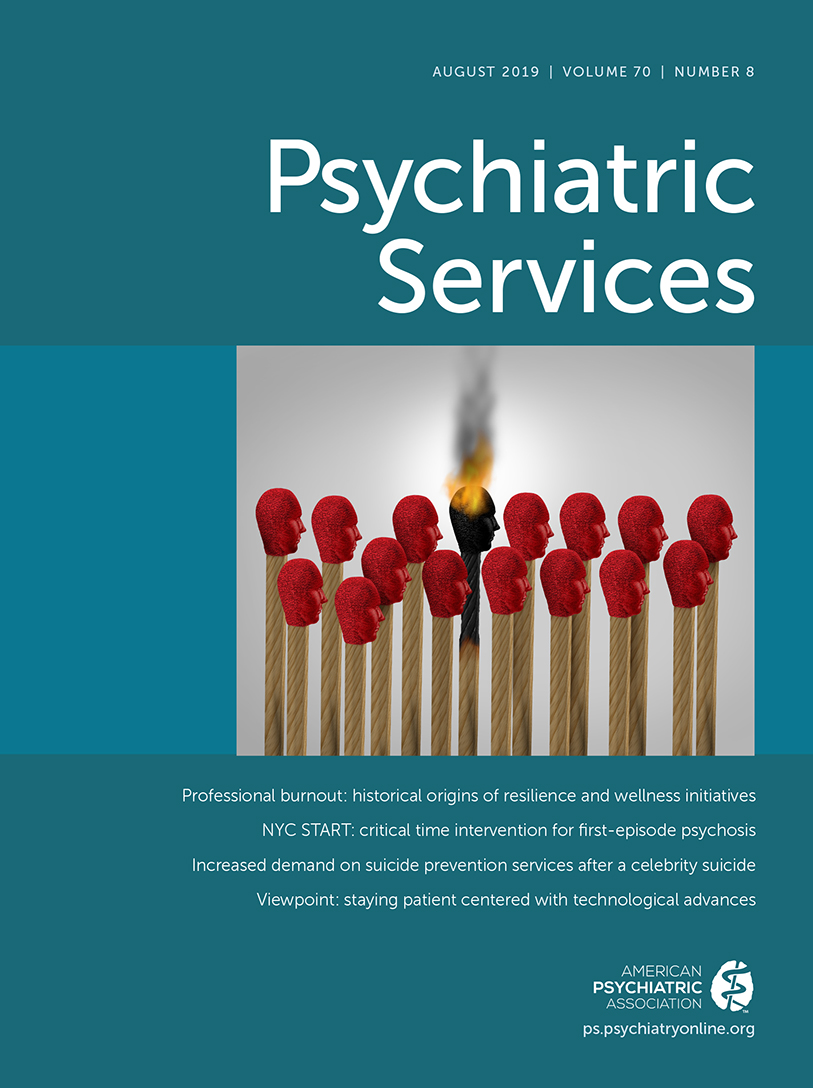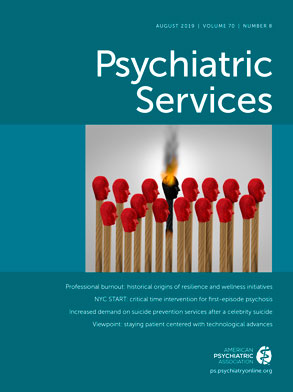Physician wellness is touted as an indicator of health care–system quality, and physician well-being is increasingly being promoted in hospitals and training programs as a major way to solve problems in the workforce (
1). The problem of “wellness” is not only managerial, it is personal: physicians attempt suicide at a greater rate than the general public and are more likely to complete the act (
2,
3). Wary of being labeled as having depression, doctors instead describe themselves as suffering from “burnout” (a similar but generally distinct phenomenon), which nevertheless may progress to depression and even suicide (
4). The American Psychiatric Association Web site states that “two of five psychiatrists have professional burnout” and “addressing this problem has become one of the most pressing issues for medicine” in general (
www.psychiatry.org/psychiatrists/practice/well-being-and-burnout). So if burnout is an illness, “resilience” is being positioned as its treatment. Resilience is sanitized as unconnected to mental illness and as an unequivocal good and attainable behavior. Resilience is the bulwark against burnout. But resilience is a political concept with political origins, designed to promote acquiescence to the status quo.
The Concept of Burnout
Before unpacking resilience, a few words must be said on burnout. The origins of burnout are manifold and have changed through time, ranging from overwork to the pressures of technological advancement and frustration in the face of complex social problems interfering with doctors’ agency (
5,
6).
In 1869, the term “neurasthenia” was used by neurologist George Beard to describe a constellation of symptoms that was thought to be caused by overwork and was connected to the pressures of urbanization. In 1974, the term “burnout” was coined by psychologist Herbert Freudenberger and then refined in the early 1980s by Christina Maslach to describe a tripartite pathology of emotional exhaustion, depersonalization (sometimes called “disengagement” or “indifference”), and reduced sense of personal accomplishment or the “tendency to evaluate one’s efforts and achievements negatively” (
7).
The historical origins of the concept of burnout have been traced to three major developments: the failure of the 1960s War on Poverty and the disillusionment of those waging it; the rapid professionalization of philanthropic and self-sacrificing jobs to those with more corporate and governmental oversight; and the cultural upheaval in the 1970s, which undermined the once tremendous authority of certain professions like doctors and teachers, as well as politicians (
5). Importantly, burnout in the 1980s was conceptualized as affecting all professions, but some medical professions in particular (doctors, at that time, not among them) were felt to be susceptible, likely due to providers’ intimate connections to those they cared for and their emotional exhaustion when patients were unable to improve.
These historical origins of burnout have been fruitfully explored to suggest avenues for intervention among doctors, including a recent call for physicians to participate in social justice and grassroots-organizing efforts to reconnect with the concepts of personal agency and altruism whose primacy has been undermined in the past decades with the rise of the electronic medical record and a focus on increasing patient loads (
6).
The Limits of Resilience
Concomitant with burnout is the concept of resilience. Much of the discourse surrounding wellness initiatives has concentrated on cultivating resilience to prevent burnout. On the surface, resilience appears to be an admirable trait. But the term “resilience” has a history that must be understood if we are to understand the ways in which it is operating in the present.
Discourse around resilience arose in the 1970s within the context of ecological studies as a description of how systems respond to disaster (
8). It was then parlayed by geographers such as Neil Adger into socioecological frameworks, using the idea to help explain how communities respond to various changes in their social, political, or environmental systems (
8). It subsequently took off as a political strategy to cultivate national resilience in the face of global strife and terrorism (
9). Environmental sociologist Raven Cretney has traced the development of resilience through time and concluded that it is currently a “popularly understood concept that distinguishes the ability to cope, respond to change and return to a degree of normal functioning following a crisis” (
8). Resilience has also come to be associated with disadvantaged individuals who overcome great obstacles or circumstances (
10), and early resiliency studies indeed focused on risk factors and protective factors among children from hostile or unfavorable environments (
11). Despite these positive understandings of resilience, this does not mean that resilience is always or inherently an essential good or a natural process; rather, it serves some purpose for someone.
Professor of International Relations Jonathan Joseph has described how the United Kingdom has “used” resilience to cultivate a sense of vulnerability in its citizens, making them responsible for their own safety while simultaneously removing this responsibility from the state. And, as the authority of some politicians waned, resilience was seen as a way of restoring some of this power by putting responsibility for troubles back in the hands of individuals instead of the state. Joseph saw this as an extension of neoliberalism (in simplistic terms, politics that focus on extreme free-market capitalism and that are not at all synonymous with “liberalism” as understood in the popular sense), which codes resilience as a “means of ‘auditing’ risk” (
9). Philosopher Oliver Davis suggested that because resilience discourse is pervasive among many different socioeconomic areas, including health care, it constructs a system in which individuals accept the status quo. Again,
“We are told that resilience is not just a reactive model that teaches people how to ‘bounce back,’ but it also encourages us to be active citizens capable of adapting to and exploiting situations of radical uncertainty. This sounds like a positive approach but it actually encourages a rather passive attitude. . . . the emphasis is on adapting to and exploiting a situation,
rather than trying to change the wider social condition. Resilience, in contrast to something like resistance, implies the
acceptance of a situation” (
9) [our emphasis].
So who does resilience serve, and for what purpose? Those who support resiliency initiatives recognize the negative health impacts of burnout and feel that resilience is something that should be cultivated to mitigate these effects. By contrast, those who lean away from resiliency projects find that they focus on the individual instead of the system. For many, resilience is a plaster on a gaping wound: not a bad idea, but one that is poorly equipped to deal with the severity of the issues at hand.
The language used by Joseph to describe the United Kingdom’s national discourse of resiliency could easily be used to describe health care systems and calls for resiliency and well-being: “It is the individual who must accept the shocks of a system deemed to be beyond our control and who must adapt their behaviour in order to survive without the guarantee of adequate state [or institutional] support” (
9). On the American Psychiatric Association Website, providers are encouraged to “take charge of your well-being” and to “assess yourself [for burnout].” The responsibility of being “well” is thus ultimately placed upon the individual, even as systems are acknowledged as being in need of modification. This again seems to empower the individual while actually distracting from potentially resisting a system that needs to be changed. Doctors are adept at working within systems, priding themselves on doing whatever is necessary. We make pliable participants who are willing to develop our resilience for what we are told is our own burnout prevention but in reality serves the institutions for which we work.
The issue thus may not be long hours, increased workloads, and excessive charting alone. The larger problem may be that medicine is no longer in the hands of medical personnel, but of those who manage providers. It is to the institutions’ and hospitals’ benefit if we not only perform better, but also take the onus upon ourselves to make sure that we do. In addition, concentrating on resilience reinforces our alienation from agency and societal mission. Just as the idea of burnout emphasizes the feelings of having suffered the loss of personal agency, resilience asks us to focus on ourselves instead of others. Both concepts tell us the answer is within ourselves, and detracts from our potential were we to rise up together.
When it comes to resilience in medicine, many would argue that initiatives meant to improve physician resilience and well-being are indeed very well intended. Training programs see their residents struggle and organize mindfulness retreats and encourage social events. Many educational packages are being developed to assess and combat burnout. However, although resilience itself is taken as value neutral, “viewing resilience as a universal good ‘assumes that the economy, community and landscape being discussed are in a desirable state that you want to maintain…[that is] undesirable states of systems can be very resilient’” (
8,
12). Resilience is a bouncing back to health and to engagement with providing good health care, but it demands that these occur within the system at hand. Again, Oliver Davis argued that “to speak of ourselves in terms of resilience is to have already accepted political defeat, to have adopted and internalized the ideology” of resilience (
10); more simply, if we talk about resilience, we’ve already “bought in,” or possibly “sold out.” Rather, it is
resistance that might be more appropriate as a response to untenable situations—not a lamenting of the past, but a call to action for the future.

